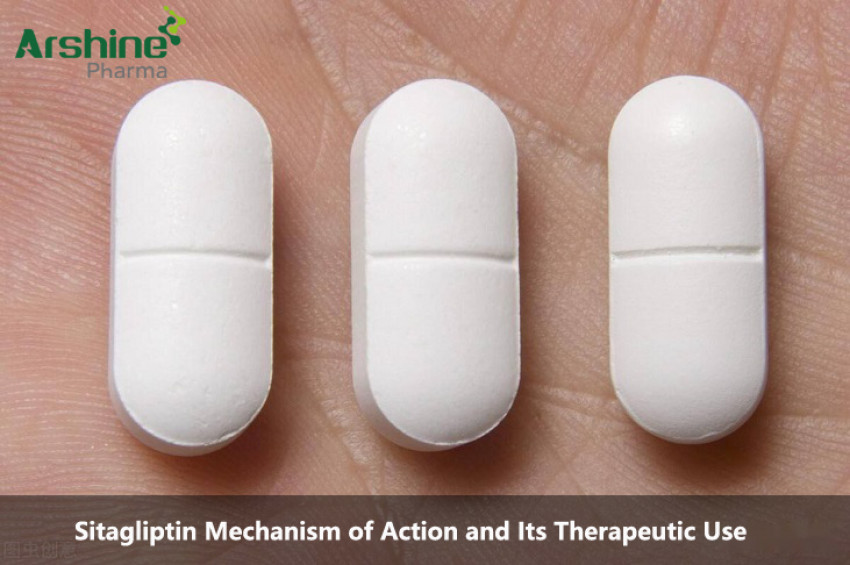
Introduction:
Sitagliptin is a medication belonging to the class of dipeptidyl peptidase-4 (DPP-4) inhibitors. It is commonly used to treat type 2 diabetes mellitus. Diabetes is a chronic metabolic disorder characterized by high blood glucose levels due to insulin resistance or inadequate insulin secretion. Sitagliptin offers a novel approach in managing this condition by targeting the incretin system, which plays a vital role in glucose homeostasis. In this article, we will explore the mechanism of action of sitagliptin and its therapeutic use in type 2 diabetes.
The Incretin System and Glucose Homeostasis:
To understand the mechanism of sitagliptin, it is essential to grasp the concept of the incretin system. Incretins are gastrointestinal hormones that are released in response to food ingestion, primarily from the small intestine. The two major incretins are glucagon-like peptide-1 (GLP-1) and glucose-dependent insulinotropic polypeptide (GIP).
Upon secretion, GLP-1 and GIP stimulate pancreatic beta cells to increase insulin secretion in a glucose-dependent manner. This means that when blood glucose levels are elevated, incretins enhance insulin release, facilitating glucose uptake by cells. Importantly, the incretins also suppress glucagon secretion from pancreatic alpha cells, preventing the release of stored glucose from the liver. Hence, incretins contribute to the regulation of glucose levels after meals and maintain glucose homeostasis in healthy individuals.
Role of DPP-4 in Inactivation of Incretins:
However, the activity of incretins is short-lived due to the action of the enzyme dipeptidyl peptidase-4 (DPP-4). DPP-4 rapidly cleaves and inactivates GLP-1 and GIP, reducing their effects on insulin secretion and glucagon suppression. This enzymatic degradation limits the incretin's ability to regulate glucose levels effectively. In individuals with type 2 diabetes, this mechanism is impaired, leading to inadequate insulin secretion and uncontrolled blood glucose levels.
Sitagliptin Mechanism of Action
Sitagliptin exerts its therapeutic effect by inhibiting DPP-4, which results in prolonged and enhanced activity of GLP-1 and GIP. By inhibiting DPP-4, sitagliptin increases the circulating levels of active GLP-1 and GIP, leading to enhanced glucose-dependent insulin secretion and reduced glucagon release.
The drug's mechanism of action involves binding to the active site of DPP-4, thereby preventing the enzyme from inactivating GLP-1 and GIP. As a result, the incretin hormones can exert their full effects on glucose regulation, improving postprandial glucose control without causing hypoglycemia during fasting periods when their activity is naturally diminished.
Pharmacokinetics:
Sitagliptin is typically administered orally in the form of sitagliptin phosphate, which is rapidly absorbed from the gastrointestinal tract. After absorption, it undergoes hepatic metabolism via the cytochrome P450 enzyme system, primarily CYP3A4 and CYP2C8. The metabolites formed are mostly inactive. The drug is excreted primarily in the urine, with a small portion eliminated in the feces.
Clinical Efficacy:
Several clinical trials have evaluated the efficacy of sitagliptin in managing type 2 diabetes. These studies have demonstrated that sitagliptin effectively lowers hemoglobin A1c (HbA1c) levels, a marker of long-term glucose control, in patients with type 2 diabetes. Additionally, sitagliptin has shown significant improvements in fasting and postprandial glucose levels compared to placebo.
Furthermore, sitagliptin has been studied both as monotherapy and in combination with other antidiabetic agents, such as metformin and sulfonylureas. Combining sitagliptin with other medications has shown synergistic effects, resulting in improved glycemic control and reduced reliance on high doses of insulin or other oral hypoglycemic agents.
Safety Profile:
Sitagliptin has generally been well-tolerated in clinical trials and real-world usage. The most common side effects reported include upper respiratory tract infections, headache, and gastrointestinal disturbances like nausea and diarrhea. These side effects are usually mild and transient.
Moreover, sitagliptin is associated with a low risk of hypoglycemia, particularly when used as monotherapy. The risk of hypoglycemia increases when sitagliptin is combined with other antidiabetic agents that can cause low blood sugar levels, such as sulfonylureas or insulin.
Contraindications and Precautions:
Although sitagliptin is well-tolerated in most patients, it is essential to consider certain contraindications and precautions before initiating treatment. Sitagliptin should not be used in individuals with a history of hypersensitivity to the drug or its components.
Furthermore, caution should be exercised when using sitagliptin in patients with renal impairment, as the drug is primarily excreted through the kidneys. Dosing adjustments may be necessary in patients with reduced renal function to avoid the risk of drug accumulation and potential adverse effects.
Conclusion:
In conclusion, sitagliptin is an effective and safe medication used to treat type 2 diabetes mellitus. Its mechanism of action involves inhibiting DPP-4, leading to increased levels of active incretins (GLP-1 and GIP). As a result, sitagliptin enhances glucose-dependent insulin secretion and suppresses glucagon release, thus improving glycemic control without causing hypoglycemia.
While sitagliptin has proven its efficacy as both monotherapy and combination therapy, it is essential to consider individual patient characteristics, including renal function, to ensure safe and optimal treatment outcomes. Overall, sitagliptin represents a valuable addition to the armamentarium of antidiabetic agents, offering a novel approach in the management of type 2 diabetes. Always consult with a healthcare professional for personalized medical advice and treatment decisions.
https://www.arshinepharma.com/new/Sitagliptin-Mechanism-of-Action




